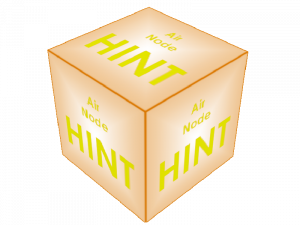info_node_air_hint
Jump to navigation
Jump to search


| CNodeEnt |
info_node_air_hint is a point entity available in all ![]() Source games.
Source games.
Entity description
A nodegraph and hint node for Flying NPCs that includes some context information for NPCs that are interested in it. The hint might indicate a window that could be looked into, or an item of interest that could be commented on. Many hint types are NPC-specific, so it's helpful to use naming conventions like 'Crow: Fly to point' in the hint choices list. The angles of a hint node indicate what direction the NPC should face to perform the hint behavior.
Identical to info_node_hint but used for airborne NPCs.
Keyvalues
- Name (targetname) <string>
- The name that other entities refer to this entity by, via Inputs/Outputs or other keyvalues (e.g.
parentnameortarget).
Also displayed in Hammer's 2D views and Entity Report. - See also: Generic Keyvalues, Inputs and Outputs available to all entities
- NodeHeight (nodeheight) <integer>
 Confirm:Ensure this much height from the ground?
Confirm:Ensure this much height from the ground?
- Pitch Yaw Roll (Y Z X) (angles) <QAngle>
- This entity's orientation in the world. Pitch is rotation around the Y axis, yaw is the rotation around the Z axis, roll is the rotation around the X axis.
Hint types - 0 : None
- 2 : World: Window
- 12 : World: Act Busy Hint
- 13 : World: Visually Interesting
- 14 : World: Visually Interesting (Don't aim at)
- 15 : World: Inhibit Combine Mines within 15 feet
- 16 : World: Visually Interesting (Stealth mode)
- 100 : Crouch Cover Medium
- 101 : Crouch Cover Low
- 102 : Waste Scanner Spawn
- 103 : Entrance / Exit Pinch
- 105 : Enemy Disadvantage Point
- 106 : Health Kit
- 400 : Antlion: Burrow Point
- 401 : Antlion: Thumper Flee Point
- 450 : Headcrab: Burrow Point
- 451 : Headcrab: Exit Pod Point
- 500 : Roller: Patrol Point
- 501 : Roller: Cleanup Spot
- 700 : Crow: Fly to point
- 701 : Crow: Perch point
- 900 : Follower: Wait point
- 901 : Override jump permission
- 902 : Player squad transition point
- 903 : NPC exit point
- 904 : Strider node
- 950 : Player Ally: Push away destination
- 951 : PLayer Ally: Fear withdrawal destination
- 1000 : HL1 World: Machinery
- 1001 : HL1 World: Blinking Light
- 1002 : HL1 World: Human Blood
- 1003 : HL1 World: Alien Blood
- Hint Activity (hintactivity) <string>
- Activity associated with this hint node. Various parts of the NPC AI play this activity at times. i.e. Actbusy nodes will play this activity when an NPC acts busy on the node.
- Node FOV (nodeFOV) <integer choices>
- Imagine this node requires that an NPC be in the node's field of view in order to use this hint.
- 45 : 45 Degrees
- 90 : 90 Degrees
- 180 : 180 Degrees
- 360 : 360 Degrees
- Start Hint Disabled (StartHintDisabled) <boolean>
- Spawn the hint disabled.
- Hint Group (Group) <string>
- If specified, gives the hint a specific group name. Useful for hint nodes that need to be logically grouped together. NPCs may also refuse to use hint nodes that don't match their hint group.
- Target node (TargetNode) <node_dest>
- The node ID of an associated target node, if any.
- Ignore Facing (IgnoreFacing) <integer choices>
- Don't pay attention to the facing of the node. May not apply to a given hint type.
- 0 : No
- 1 : Yes
- 2 : Default
- Radius (radius) <integer>
- Allows hints to only be usable in a pre-defined radius(in all games since
 )(also in
)(also in  )
)
- Weight (hintweight) <integer>
- Allows NPCs to prefer certain hints over others (only in
 )
)
- Minimum State (MinimumState) <integer choices>
- Require an NPC have a minimum state to use the hint.
- 1 : Idle
- 2 : Alert
- 3 : Combat
- Maximum State (MaximumState) <integer choices>
- Require an NPC have a maximum state to use the hint.
- 1 : Idle
- 2 : Alert
- 3 : Combat
- Node ID (nodeid) <integer>
- Read-only internal Hammer value.
Flags
- Allow jump up : [65536]
Inputs
HintNode:
- EnableHint
- Enable hint.
- DisableHint
- Disable hint.
